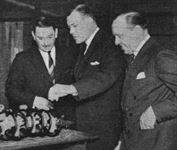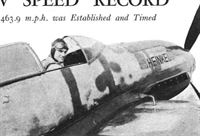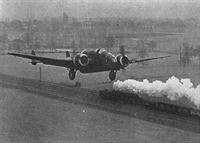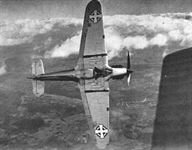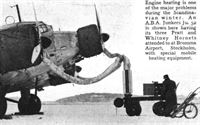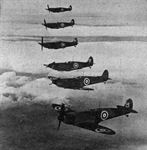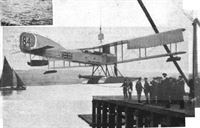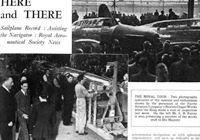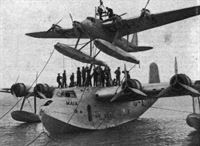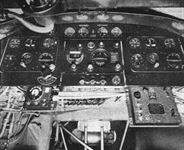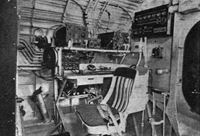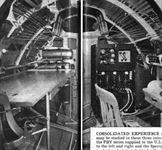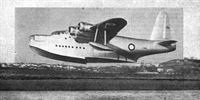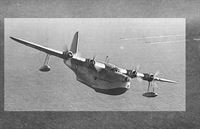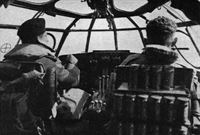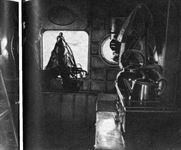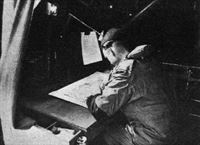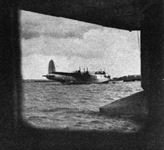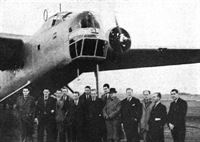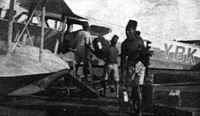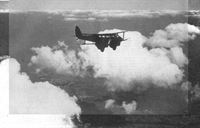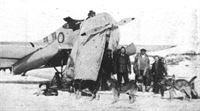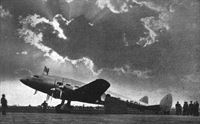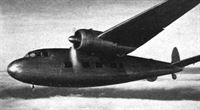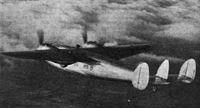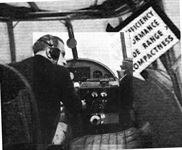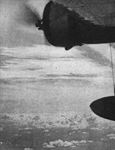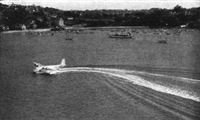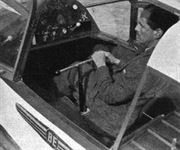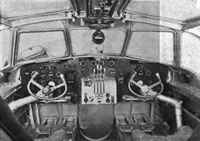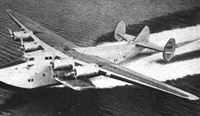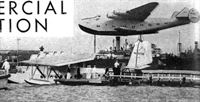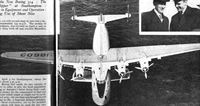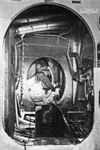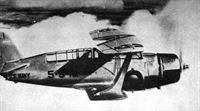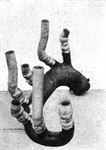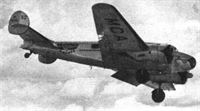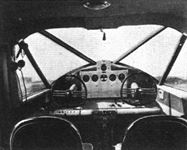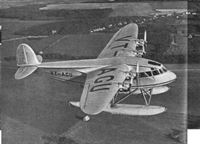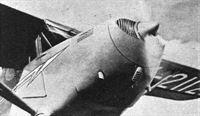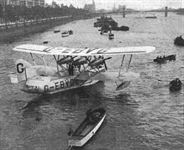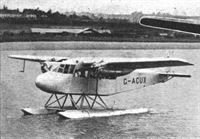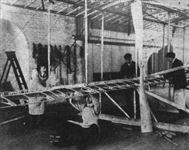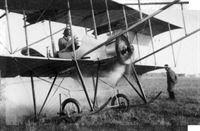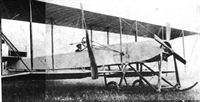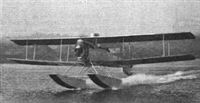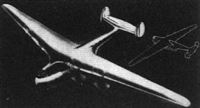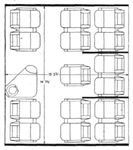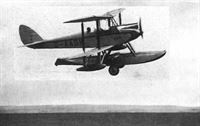Фотографии
-
Регистрационный номер: L8466 THE RISING TIDE: This impressive photograph points its own <...>. It was taken inside Rootes’ shadow factory at Speke, Liverpool, which was inspected by the Secretary of State for Air last week. The Blenheims are lifted out of the lines by overhead cranes as completed.
Самолёты на фотографии: Bristol Blenheim - Великобритания - 1936
-
Capt Harold Balfour, Under-Secretary of State for Air (and a very accomplished pilot), paid a visit last Friday to Rootes’ shadow factory at Liverpool. He is seen examining Blenheim tail-trimming controls in company with Mr. W. E. Rootes (right), chairman of Rootes’ Securities, and Mr. Trowbridge, works manager of the factory.
Самолёты на фотографии: Bristol Blenheim - Великобритания - 1936
-
An impressive line-up of part of the transcontinental and Western Air Fleet at Newark Airport, New Jersey; this sort of picture brings air transport into its true perspective.
Самолёты на фотографии: Douglas DC-3 / C-47 Skytrain/С-53 Skytrooper / Dakota - США - 1935
-
Регистрационный номер: NC16030 COMING IN: The machine shown about to land with flaps and wheels lowered is Douglas D.C.3.
Самолёты на фотографии: Douglas DC-3 / C-47 Skytrain/С-53 Skytrooper / Dakota - США - 1935
-
Two shots from the Pathe Gazette newsreel. The machine shown in it has a radio mast. Those unfamiliar with cine technique will be interested in the sound track in the picture right
Самолёты на фотографии: Heinkel He-100 - Германия - 1938
-
The pilot, Dieterle, was promoted to Flight Captain on breaking the record.
Самолёты на фотографии: Heinkel He-100 - Германия - 1938
-
FASTEST ON THE LEVEL: Flight Captain Dieterle in the specially prepared Heinkel in which he is claimed to have covered 3 km. (1.86 miles), at a speed of 463.8 m.p.h. Presumably - though confirmation is unobtainable - this was a two-way mean speed. The engine is a Daimler Benz inverted vee-twelve of unknown horse-power, but certainly delivering more than the 1,175 h.p. quoted in the Press.
Самолёты на фотографии: Heinkel He-100 - Германия - 1938
-
Регистрационный номер: L4135 TRACTIVE EFFORT: Capt. J. H. Cordes retracts the undercarriage of a Hampden as he passes - on the L.M.S. line skirting Handley Page’s Radlett Aerodrome - a “Garratt” type locomotive, which is capable of a tractive effort of 45,620 lb. The combined take-off output of the Pegasus engines of the Hampden is between 1,900 and 2,000 h.p.
Самолёты на фотографии: Handley Page Hampden / H.P.52 - Великобритания - 1936
-
AERIAL PORTRAIT: Sqn. Ldr. J. W. Donaldson of tne Station Flight, Northolt, smiles polite acquiescence to the proximity of the photographic Hart to his Hurricane.
Самолёты на фотографии: Hawker Hurricane - Великобритания - 1935
-
HURRICANES FOR YUGO-SLAVIA. It may be remembered that Yugo-Slavia purchased a batch of Hawker Furies some time ago. The excellent service which these have given has, no doubt, induced that country to purchase (and ultimately to build under licence) the Hurricane. This Flight photograph shows one of the machines “posed” at a striking angle by Flt. Lt. R. C. Reynell, one of the Hawker test pilots.
Самолёты на фотографии: Hawker Hurricane - Великобритания - 1935
-
Engine heating is one of the major problems during the Scandinavian winter. An A.B.A. Junkers Ju.52 is shown here having its three Pratt and Whitney Hornets attended to at Bromma Airport, Stockholm, with special mobile equipment.
Самолёты на фотографии: Junkers Ju.52/3m - Германия - 1931
-
FAST FORMATION: The first picture released for publication of Vickers Supermarine Spitfires in formation. This formidable fighter, with Rolls-Royce Merlin II engine, is capable of 362 m.p.h. Take-off, climb and cruising speed will be improved upon when three-bladed v.p. airscrews are fitted.
Самолёты на фотографии: Supermarine Spitfire - Великобритания - 1936
-
Регистрационный номер: 184 An Early Torpedo 'Plane: The famous Short "225 " being launched at Rochester in 1916.
The foundation of a seaplane reputation: One of the first torpedo-carrying seaplanes of the “Two-two-five” type being launched at Rochester in 1915.Самолёты на фотографии: Short Type 184/225/827/830/310/320 - Великобритания - 1914
-
THE ROYAL TOUR: Two photographs indicative of the interest and enthusiasm shown by the personnel of the Fairey Aviation Company’s Heaton Chapel Works when the King made a visit of inspection last week. On the left Mr. C. R. Fairey is seen presenting a member of the works staff to His Majesty.
Самолёты на фотографии: Fairey Battle - Великобритания - 1936
-
Регистрационный номер: G-ADHJ, G-ADHK Composition: Mercury being loaded on to Maia.
Самолёты на фотографии: Short Mayo Composite (S.20 Mercury and S.21 Maia) - Великобритания - 1938
-
With the S.41 (100 h.p. Gnome) Shorts, in 1912, laid the foundation for their famous seaplanes. The machine in the picture was piloted by Commander Samson, and the passenger was Mr. Winston Churchill, then First Lord of the Admiralty.
Самолёты на фотографии: Short S.41 / RNAS 42 seaplane - Великобритания - 1912
-
Регистрационный номер: L4842 HIGH FLYER: The excellent lines of the Short 14/38 landplanes ordered by the Air Ministry may be studied in these views of a model. Fitted with Bristol Hercules engines giving 1,100 h.p. at 22,000 feet, one version (Type B), will cruise at 275 m.p.h. at 25,000 feet.
Самолёты на фотографии: Bristol Blenheim IV/Bolingbroke - Великобритания - 1937
-
Регистрационный номер: NC777, AM528, G-AGBJ, SM706 The commercial version of the Consolidated Model 28 long-range flying boat is exemplified by Richard Archbold’s Guba.
Самолёты на фотографии: Consolidated PBY Catalina - США - 1935
-
CONSOLIDATED EXPERIENCE: Much that is sound in the layout of equipment of modern multi-engined long-range aircraft may be studied in these three interior views of the Consolidated Model 28 twin-engined flying boat, which is generally similar to the PBY series supplied to the U.S. Navy. In the view (pilots’ instrument panel; the duplicated blind flying panels are seen to the left and right and the Sperry automatic pilot panel is in the centre. The finger-hole dial on the left is apparently a remote control spot-wave selector for the radio. Upper centre is a small warning light indicating the motion of the retractable wing-tip floats.
Самолёты на фотографии: Consolidated PBY Catalina - США - 1935
-
In the view (the same compartment from another angle) are the radio receiver and, high up on the bulkhead, the main electrical switch panel.
Самолёты на фотографии: Consolidated PBY Catalina - США - 1935
-
The view shows the radio-navigator’s compartment, looking forward, with the transmitter on the right.
Самолёты на фотографии: Consolidated PBY Catalina - США - 1935
-
An artist’s impression of an amphibian version of this type which is under development. It will have twin nose wheels.
Самолёты на фотографии: Consolidated PBY Catalina - США - 1935
-
HISTORICAL: This 6-ft. span model of the famous Blackburn Kangaroo has been presented to Hull Municipal Museums by Blackburn Aircraft Ltd The Kangaroo (with two Sunbeam engines and later with Rolls-Royce Falcons) was designed in 1916 as a bomber and submarine spotter and a number were constructed as landplanes. After the war some were modified for passenger transport, as seen in the model. They were also used for the training of R.A.F. Reserve officers at Brough until as late as 1929.
Самолёты на фотографии: Blackburn Kangaroo / R.T.1 - Великобритания - 1917
-
COMING IN: The machine shown about to land with flaps and wheels lowered is Heinkel He 111
Самолёты на фотографии: Heinkel He-111 - Германия - 1935
-
Регистрационный номер: D-AMHC Самолёты на фотографии: Focke-Wulf FW.200 Condor - Германия - 1937
-
Регистрационный номер: OY-DEM TWO CROYDON NEWCOMERS: In the foreground is the new 1,000-gallon Intava service tanker. The tanker unit is refuelling the Focke-Wulf Condor Jutlandia, belonging to Det Danske Luftfartselskab, at the end of a service run from Copenhagen.
Самолёты на фотографии: Focke-Wulf FW.200 Condor - Германия - 1937
-
Регистрационный номер: D-ACON, D-AERE FOUR-ENGINED FASHIONS: the Focke-Wulf Condor
Самолёты на фотографии: Focke-Wulf FW.200 Condor - Германия - 1937
-
Регистрационный номер: G-ADSR FOUR-ENGINED FASHIONS: the Armstrong-Whitworth Ensign.
Самолёты на фотографии: Armstrong Whitworth Ensign / A.W.27 - Великобритания - 1938
-
The Ensign cabin in standard medium-range form.
Самолёты на фотографии: Armstrong Whitworth Ensign / A.W.27 - Великобритания - 1938
-
This picture of a model of the Fairey F.C-1. gives a good idea of how the machine will look. It is possible that the triple-rudder arrangement will give way to a twin-rudder type of tail. The engines will be Bristol Taurus of about 1,000 h.p. each; it is expected to cruise at 220 m.p.h.
Самолёты на фотографии: Fairey FC.1 - FC.6 - Великобритания - 1939
-
Регистрационный номер: G-AFMK HIGH FLYER: The excellent lines of the Short 14/38 landplanes ordered by the Air Ministry may be studied in these views of a model. Fitted with Bristol Hercules engines giving 1,100 h.p. at 22,000 feet, one version (Type B), will cruise at 275 m.p.h. at 25,000 feet.
Самолёты на фотографии: Short S.32 - Великобритания - 1939
-
Регистрационный номер: L3057 NOT-SO-MYTHICAL. According to the encyclopaedia, the roc was a fabulous bird of the East, so huge that it bore off elephants to feed its young. The Blackburn Roc, of which details are now released, is neither fabulous nor gigantic, but it is obviously a very efficient two-seater fighter for the Fleet Air Arm. It closely follows the lines of the Skua, and the engine is a Bristol Perseus. Either a retractable wheel undercarriage or a float undercarriage may be fitted.
Самолёты на фотографии: Blackburn Roc / B-25 - Великобритания - 1938
-
The Fokker G-I (two Bristol Mercury or Perseus) diving with air-brakes applied.
Самолёты на фотографии: Fokker G.I Le Faucheur - Нидерланды - 1937
-
FOR PATROL AND BOMBING: A new Short Sunderland flying boat, several of which type have already been delivered to the R.A.F., taking off for a test flight from the Medway.
The Short Sunderland military flying boat, which is capable of 210 m.p.h., has been developed from the commercial Empire type. The engines are four Pegasus XXIIs.Самолёты на фотографии: Short Sunderland / S.25 - Великобритания - 1937
-
Регистрационный номер: L5806 Shorts To-day: The Sunderland, with four Bristol Pegasus XXII engines of 850 h.p. each, a span of 112ft. 9in. and a normal weight of 44,460 lb.
Pre-war photograph of Short Sunderland I L5806, one of a batch of ten Sunderlands delivered to the RAF in late 1938. After service with Nos 228, 210, 228 and 230 Sqns L5806 went missing on July 7, 1942.Самолёты на фотографии: Short Sunderland / S.25 - Великобритания - 1937
-
The Short Sunderland (four Bristol Pegasus XXII) offers - on two floors - plenty of home comforts for its crew. These interior views were taken by Flight's chief photographer during the escort flight for the French President’s visit. This one shows a control cabin view (the cylinders in the rack are Very cartridges)
Самолёты на фотографии: Short Sunderland / S.25 - Великобритания - 1937
-
The Short Sunderland (four Bristol Pegasus XXII) offers - on two floors - plenty of home comforts for its crew. These interior views were taken by Flight's chief photographer during the escort flight for the French President’s visit. This one shows a member of the crew handling a drogue from the galley hatch (note the homely kettle and teapot)
Самолёты на фотографии: Short Sunderland / S.25 - Великобритания - 1937
-
The Short Sunderland (four Bristol Pegasus XXII) offers - on two floors - plenty of home comforts for its crew. These interior views were taken by Flight's chief photographer during the escort flight for the French President’s visit. This one shows the navigator at work
Самолёты на фотографии: Short Sunderland / S.25 - Великобритания - 1937
-
The Short Sunderland (four Bristol Pegasus XXII) offers - on two floors - plenty of home comforts for its crew. These interior views were taken by Flight's chief photographer during the escort flight for the French President’s visit. This one shows a glimpse through a window
Самолёты на фотографии: Short Sunderland / S.25 - Великобритания - 1937
-
Регистрационный номер: D-AGNT A view including the Dornier Do.26 four-engined long-range flying boat (on the water) and the earlier Do.18.
Самолёты на фотографии: Dornier Do.18 - Германия - 1935Dornier Do.26 - Германия - 1938
-
A dramatic stage in a take-off by the prototype Consolidated XPB2Y-1 flying boat of the U.S. Navy. The engines are Pratt and Whitney Twin Wasps.
Самолёты на фотографии: Consolidated PB2Y Coronado - США - 1937
-
THE MEN AND THE JOB: A group snapped at the Belfast Works of Short and Harland Ltd., after a test flight of the first production Bombay bomber transport. Fifth from the right is Mr. J. H. Lower (manager) and the fourth from the right is Mr. H. L. Piper, of Short Brothers, who has been carrying out the test flying.
Самолёты на фотографии: Bristol Bombay / Type 130 - Великобритания - 1935
-
Unloading a R.A.N.A. Rapide at Beira, where the company's service links up with that of Imperial Airways; the golf clubs remove any false ideas about "darkest Africa."
Самолёты на фотографии: De Havilland Dragon Rapide / Dominie / D.H.89 - Великобритания - 1934
-
One of Western Airways D.H. Rapides over Weston-super-Mare; the company’s base aerodrome is half-covered by chud on the right of the picture.
Самолёты на фотографии: De Havilland Dragon Rapide / Dominie / D.H.89 - Великобритания - 1934
-
Two of the four standard seating arrangements for the D.H. Rapide. That above is for short-distance work.
Самолёты на фотографии: De Havilland Dragon Rapide / Dominie / D.H.89 - Великобритания - 1934
-
A Canadian Airways Junkers W.34 at Fort Chipewyan, with local inhabitants and a dog team to take the mail and freight from the machine to the settlement. Note the tarpaulin cover on the engine and the two canoes lashed to the underside of the wings.
Самолёты на фотографии: Junkers W 33 / W 34 / Ju.46 - Германия - 1926
-
The smaller twin-engined commercial types are represented by the German Siebel Fh 104 with two Hirth or Argus engines.
Самолёты на фотографии: Siebel Fh.104 Hallore - Германия - 1937
-
The layout of the Savoia Marchetti S.M. 75 three-engined machine may be studied here. This model has been adopted by a number of airlines.
Самолёты на фотографии: Savoia-Marchetti / SIAI SM.75 - Италия - 1937
-
Регистрационный номер: VP-YBW The Travelling Flying School ready for action with the instructor’s car, the tent and the Tiger Moth. The place is Gatooma, Rhodesia
Самолёты на фотографии: De Havilland Tiger Moth / D.H.82 - Великобритания - 1931
-
Регистрационный номер: G-AFDI Operating the world's fastest scheduled service - the D.H. Albatross, which cruises at 210 m.p.h., at Croydon.
Самолёты на фотографии: De Havilland Albatross / D.H.91 - Великобритания - 1937
-
Регистрационный номер: G-AEVV FOUR-ENGINED FASHIONS: the De Havilland Albatross
Самолёты на фотографии: De Havilland Albatross / D.H.91 - Великобритания - 1937
-
The seating layout of the D.H. Albatross as arranged for Imperial Airways' European services.
Самолёты на фотографии: De Havilland Albatross / D.H.91 - Великобритания - 1937
-
Регистрационный номер: G-AFUE [2] Britain’s most recent commercial machine is the De Havilland Flamingo, which has an excellent performance with two Bristol Perseus sleeve-valve engines.
Самолёты на фотографии: De Havilland Flamingo / D.H.95 - Великобритания - 1938
-
Регистрационный номер: G-AFUE [2] This country’s first all-metal medium-capacity transport - the D.H. Flamingo which, like the Albatross, cruises at 210 m.p.h.
Самолёты на фотографии: De Havilland Flamingo / D.H.95 - Великобритания - 1938
-
This view of the Hennes Transreceiver two-way aircraft radio equipment gives a good idea of its compact size. (General Aircraft Ltd.).
Самолёты на фотографии: General Aircraft Monospar ST-25 Universal - Великобритания - 1935
-
Регистрационный номер: VH-ABL, G-AFMT In its latest retractable-uncarriage form - the Percival Q.6, which has a maximum speed of more than 200 m.p.h. on the Gipsy Six engines.
Самолёты на фотографии: Percival Petrel / Q.6 - Великобритания - 1937
-
TUCKED UP: The Percival Q6 in its latest form, with undercarriage retracted. This machine is one of two for Australia.
Самолёты на фотографии: Percival Petrel / Q.6 - Великобритания - 1937
-
The Percival Q.6 cabin as laid out for airline work. A toilet compartment may be arranged in place of the seventh seat.
Самолёты на фотографии: Percival Petrel / Q.6 - Великобритания - 1937
-
Регистрационный номер: G-AFAV Hardly in the transport class, but nevertheless a useful type for charter and feeder-line work - the Percival Vega Gull.
Самолёты на фотографии: Percival Vega Gull / K.1 - Великобритания - 1935
-
Регистрационный номер: G-ADHM SOLITUDE: This photograph was taken by Capt. A. S. Wilcockson, of Imperial Airways, at 11,000ft. over the Atlantic during one of Caledonia's experimental flights along the Foynes - Botwood route in 1937.
Самолёты на фотографии: Short Empire / S.23 - Великобритания - 1936
-
Регистрационный номер: G-AFBK, VH-ABB The Qantas Empire Airways base at Rose Bay, Sydney, with one of the Qantas Empire boats - actually Coolangatta - being warmed up in the customary manner.
Самолёты на фотографии: Short Empire / S.23 - Великобритания - 1936
-
Регистрационный номер: G-AFCU [2] G-AFCU Cabot сфотографирована в начале отрыва от водной поверхности. Это одна из улучшенных S.30, выполнившая первый полет в декабре 1938 года. В декабре 1939 года лодку передали британским ВВС, а в мае 1940 года она была уничтожена в норвежском Бодё.
First of the strengthened Empire class, fitted with Perseus sleeve-valve engines and designed to carry a greater pay load, is Cabot, seen taking off from the Medway.Самолёты на фотографии: Short Empire / S.23 - Великобритания - 1936
-
Регистрационный номер: G-AFCU [2] The first of the strengthened C-class Short boats on an early test outing. Cabot, which will be used for refuelled Atlantic experimental flights.
Самолёты на фотографии: Short Empire / S.23 - Великобритания - 1936
-
Регистрационный номер: G-ADHL A new era in commercial flying was opened up with the introduction of the Short Empire flying boat.
Самолёты на фотографии: Short Empire / S.23 - Великобритания - 1936
-
Регистрационный номер: OK-BET, G-AGSR Cleanly conventional in the modern manner, the Bibi has no unnecessary protuberances - hence the performance.
Самолёты на фотографии: Benes-Mraz Be.550 Bibi - Чехословакия - 1936
-
Inside the two-seater cabin. Notice the door entry width and height, and the quaint but practical control column arrangement. The throttles work downwards to open and a built-in fire extinguisher (right) is fitted as standard.
Самолёты на фотографии: Benes-Mraz Be.550 Bibi - Чехословакия - 1936
-
The lines of the 550 are shown in these general arrangement drawings.
Самолёты на фотографии: Benes-Mraz Be.550 Bibi - Чехословакия - 1936
-
Регистрационный номер: F-ARAY FOUR-ENGINED FASHIONS: the Potez 662 which, fitted with four small-diameter Gnome Rhone engines, is probably the fastest transport machine in the world.
Самолёты на фотографии: Potez Potez 661 - Франция - 1937
-
Регистрационный номер: F-AOUJ One of Air France’s latest types - the Liore 246 - 26-passenger flying-boat. Six of these machines have been ordered for the company’s Mediterranean services.
The prototype LeO H 246 F-AOUJ. It made its first flight from Etang de Berre on September 30, 1937.Самолёты на фотографии: Liore et Olivier LeO H.246 - Франция - 1937
-
The Blohm and Voss Ha 139 long-distance float-plane, with four Junkers Jumo 205 heavy oil engines.
Самолёты на фотографии: Blohm und Voss Ha.139 - Германия - 1936
-
An example of duplicated instrument-flying panels - interesting because it is the control cabin of the Dornier Do.26 four-engined transatlantic flying boat. Notice the two distant-reading compass dials at the top of the panels.
With a separate engineer’s control panel, it has been possible to simplify the layout of the new Dornier’s instrument board. Note the twist-grips on the spectacle controls and the accessibility of the D/F loop gear.Самолёты на фотографии: Dornier Do.26 - Германия - 1938
-
FOUR-ENGINED FASHIONS: the Heinkel He 116, which can be used as a passenger machine or long range mail carrier;
Самолёты на фотографии: Heinkel He-116 - Германия - 1937
-
FOUR-ENGINED FASHIONS: the Junkers Ju 90
Самолёты на фотографии: Junkers Ju.90 - Германия - 1937
-
Регистрационный номер: OA-BBO One of the Faucett specials used by C. de A. "Faucett" outside the terminal building at Santa Cruz aerodrome, Lima, Peru.
Самолёты на фотографии: Faucett-Stinson F-10 / F-19 - Перу - 1934
-
The Bellanca "Junior" 14-9 Three-seat Cabin Monoplane (90 h.p. Le Blond engine).
The new Bellanca Junior in its retractable undercarriage form. It has the familiar Bellanca wing shape and section.Самолёты на фотографии: Bellanca 14 Junior / Cruisair / 17 Viking - США - 1937
-
The most advanced commercial flying-boat in the air to-day is the Boeing 314, the layout which is apparent on the photo. The engines are four Wright two-row Cyclones of about 1,500 h.p. each.
Самолёты на фотографии: Boeing Boeing 314 Clipper - США - 1938
-
Регистрационный номер: NC16736, NC18603 [3] READY FOR THE CROSSING: The Boeing 314 Yankee Clipper cutting things fine while making an approach at Baltimore after flying over from San Francisco. The machine at the landing stage is the Sikorsky S.42B Bermuda Clipper, which is now being assisted on the Bermuda service by the second of the 314s, Allanite Clipper. At the time of going to press Yankee Clipper was at Biscarosse.
Самолёты на фотографии: Boeing Boeing 314 Clipper - США - 1938Sikorsky S-42 Clipper - США - 1934
-
Регистрационный номер: NC18603 [3] The side elevation lines of the Yankee Clipper are shown well in this photograph taken while the machine was making one of its pre-landing circuits over the Southampton area.
Самолёты на фотографии: Boeing Boeing 314 Clipper - США - 1938
-
Some idea of the size of the machine and the area of the sponsons may be gained from this photograph of the crew being taken aboard one of the Imperial Airways’ Power tenders.
Самолёты на фотографии: Boeing Boeing 314 Clipper - США - 1938
-
Регистрационный номер: NC18603 [3] The Boeing at Southampton. The outlines on the wings, fuselage and sponsons evidently indicate the areas on which the crew may walk.
Самолёты на фотографии: Boeing Boeing 314 Clipper - США - 1938
-
All that the pilots need to look after; one of the control boxes in the pilots’ compartment, with the throttle levers on the left and the trimming controls and indicators on the right, with master controls for the mixture and manifold pressures. On the extreme right is a remote-control panel for intercommunication and radio homing purposes.
Самолёты на фотографии: Boeing Boeing 314 Clipper - США - 1938
-
The engineer’s controls and instruments are shown in detail - complete with pencil-sharpener; among other things the engineer looks after the engine cooling flaps, manifold pressures and the automatic mixture controls.
Самолёты на фотографии: Boeing Boeing 314 Clipper - США - 1938
-
The photograph shows the size of the engine maintenance walkways in the wing.
Самолёты на фотографии: Boeing Boeing 314 Clipper - США - 1938
-
The picture gives an idea of the freedom and space which is available for the navigator - notice the telescopic drift-sight and the essential flying instruments on the left of the chart table.
Самолёты на фотографии: Boeing Boeing 314 Clipper - США - 1938
-
OVER SAN FRANCISCO BAY: One of the 1939 four-seater Cessnas actually the company’s photographic machine - with a typically Californian crystal-clear background. The new Cessna carries a useful load of 1,000 lb. with a gross weight of only 2,350 lb., and has a top speed of 162 m.p.h.; it is fitted with a Warner Scarab engine of 145 h.p. The agents in this country are Aviation Corporates.
Самолёты на фотографии: Cessna Airmaster / C-34 / C-38 / C-145 / C-165 - США - 1935
-
"Double-split" flaps on the trailing edges of the lower wings retard the diving speed of the Curtiss SBC-3 dive bomber.
Самолёты на фотографии: Curtiss SBC Helldiver - США - 1934
-
Регистрационный номер: NX18100 Half an exhaust collector ring, with Ryan universal joints, as fitted to one of the Cyclone 14s of the Douglas DC-4.
Самолёты на фотографии: Douglas DC-4E - США - 1938
-
The Douglas D.C.4 is the largest landplane now flying and incorporates a number of features making for high commercial efficiency.
Самолёты на фотографии: Douglas DC-4E - США - 1938
-
COMING IN: The machine shown about to land with flaps and wheels lowered is a Lockheed Electra
Самолёты на фотографии: Lockheed Electra 10 - США - 1934
-
Регистрационный номер: G-AFMO BUDAPEST-BOUND: A Lockheed Fourteen taxying out to take off for the first Frankfurt-Budapest run. Notice the fixed “letter-box” slots near the wing tip and Heston’s major obstruction - the Southall gasholder.
Самолёты на фотографии: Lockheed Super Electra 14 - США - 1937
-
Регистрационный номер: PJ-AIT K.L.M. run a number of useful services in the West Indies: This photograph shows one of their Lockheed 14s being refuelled at Barranquilla, in Colombia. S.C.A.D.T.A. is that country’s own operating company and the name will be seen on the terminal building behind the tail of the 14.
Самолёты на фотографии: Lockheed Super Electra 14 - США - 1937
-
At the Trans-Canada Air Lines’ operational base at Winnipeg, with two of the company’s Lockheed 14s on the tarmac.
Самолёты на фотографии: Lockheed Super Electra 14 - США - 1937
-
Inside the latest Stinson Reliant: The neatness of the instrument and control layout is noteworthy; presumably the large panel can take other instruments, such as those of the free gyro type, when these are ordered. The cowling of the latest Reliant has, incidentally, been changed both to improve the lines and to increase the accessibility.
Самолёты на фотографии: Stinson Reliant - США - 1933
-
The Timm transport (two Wright Whirlwinds), which, like the larger Douglases, has a tricycle undercarriage.
Самолёты на фотографии: Timm T-840 Aeromold Transport - США - 1938
-
Регистрационный номер: VT-AGU SHORT BROTHERS' LATEST: The Scion Senior carries up to ten passengers at a maximum speed of 134 m.p.h. although its four Pobjoy Niagara engines develop a total of only 360 b.h.p. The next machine to be built will have a wheel undercarriage.
Самолёты на фотографии: Short Scion Senior / S.22 - Великобритания - 1935
-
Самолёты на фотографии: Stinson Voyager / Model 105 / Model 108 - США - 1939
-
The new Stinson “105” and a close-up of the exceptionally neat pressure-type engine cowling for the 75 h.p. Continental. In general appearance the "105" may be described as a cross between the well-known Reliant and the typical American lightweight of to-day. The machine has a cruising speed of 105 m.p.h.
Самолёты на фотографии: Stinson Voyager / Model 105 / Model 108 - США - 1939
-
One of the very latest attack-bombers which can be used either for normal bombing or for "strafing" ground targets: the Stearman (Boeing) X-100;
Less attractive in line than the other American "attack bombers" the Stearman X-100 displays some very practical features. It is said to be a good production job.Самолёты на фотографии: Stearman A-21 (Boeing-Stearman) - США - 1938
-
Developments of Singapore I - the Singapore II, with four Rolls-Royce Kestrels.
Самолёты на фотографии: Short Singapore I / S.5 - Великобритания - 1926
-
Регистрационный номер: G-EBUP, N179 The Short Singapore used by Sir Alan Cobham when he made an initial survey of the Cairo-Cape route in 1928 - a picture taken on his return to Rochester.
The Singapore I of 1927 was originally fitted with Rolls-Royce Condors, though Buzzards were eventually substituted.Самолёты на фотографии: Short Singapore I / S.5 - Великобритания - 1926
-
Регистрационный номер: N120 The Cromarty, with two Rolls-Royce Condors.
Самолёты на фотографии: Short N.3 Cromarty - Великобритания - 1921
-
Регистрационный номер: G-EBVG Londoners were treated to a close-up view of Britain’s then latest commercial flying boat when, in 1928, Mr. Lankester Parker, with Mr. Oswald Short on board, put a Calcutta down on the Thames at Westminster for M.P.s to inspect.
Самолёты на фотографии: Short Calcutta / Rangoon / S.8 - Великобритания - 1928
-
Регистрационный номер: G-ACUX, VH-UUP Interchangeable wheel and float undercarriages gave the popular little Scion a wide field of application.
Самолёты на фотографии: Short Scion / S.16 - Великобритания - 1933
-
Регистрационный номер: J7296 Built to a military specification, the Springbok was a development of the Silver Streak.
Самолёты на фотографии: Short Springbok / Chamois / S.3 - Великобритания - 1923
-
Shorts in the beginning: Their first machine, a biplane, had a front elevator and wing-tip rudders. It never actually left the ground.
Самолёты на фотографии: Short Biplane - Великобритания - 1909
-
The view shows the machine, “Short No. 1,” being built under railway arches at Battersea in 1908.
Самолёты на фотографии: Short Biplane - Великобритания - 1909
-
Another interesting machine, one of which was owned by Moore-Brabazon, was the British-built Short biplane shown in the illustration. As will be seen, this machine was very similar to the Wright biplane - and also used the starting rail - the main differences being in the "chassis" and control surfaces.
"Short No. 2" resembled No. 1, but the rudder was carried on outriggers and not on the wing tips. Note the unusual lateral controllers. On this machine Lt. Col. Moore-Brabazon flew a mile in a closed circuitСамолёты на фотографии: Short Biplane No.2 - Великобритания - 1909
-
The Short “Double Twin” of 1911 had two rotary engines, with the pilot placed between them.
One of the most influential and yet least-known of British aviation pioneers, Frank McClean acquired the land at Eastchurch in November 1909 and gave use of it to the RAeC for a fixed annual rent of a shilling. Seen here is his modified Short S.27, known as the “Tandem Twin” or “Double Dirty”.Самолёты на фотографии: Short Tandem Twin / S.39 Triple Twin - Великобритания - 1911
-
The “Triple Twin” had two rotary engines and three airscrews.
Самолёты на фотографии: Short Tandem Twin / S.39 Triple Twin - Великобритания - 1911
-
A development of the first tractor biplane had a single central float and two outboard air bags for stabilising.
Самолёты на фотографии: Short S.36 / S.45 tractor biplane - Великобритания - 1912
-
Search for better efficiency led to the first Short tractor biplane (70 h.p. Gnome rotary).
A much modified ex-Grace S.27 in its final tractor form . It had been Grace's idea to convert it in this way, but work slowed down after his death and Frank McClean had it finished later.Самолёты на фотографии: Short S.36 / S.45 tractor biplane - Великобритания - 1912
-
One of the S38s with the c/n. 559 on the heel of the rudder.
The Short S.38 showed Farman influence, but differed in having a nacelle and a front elevator. The engine was a Gnome rotary. In this picture Oswald Short is in the pilot’s seat and Eustace is the passenger.Самолёты на фотографии: Short S.38 - Великобритания - 1912
-
The Short Triple Tractor showing the 16-ft. long cowling in which the two Gnome engines were located.
Самолёты на фотографии: Short S.47 triple tractor biplane - Великобритания - 1912
-
Highland Airways - now part of the Scottish Airways system - pioneered the Orkney service. Here is the old Monospar S.T.4 as it was delivered for the Inverness-Kirkwall run in April, 1933; Capt. E. E. Fresson is on the left.
Самолёты на фотографии: General Aircraft Monospar ST-4 - ST-12 - Великобритания - 1932
-
The Major might be described as a miniature Puss Moth and this flying view shows the similarities as well as the differences - notably a thick wing section.
Самолёты на фотографии: Luton Major - Великобритания - 1939
-
Регистрационный номер: G-AFMU This picture - from the “entry” side - gives an idea of the range of view provided for the occupants.
Самолёты на фотографии: Luton Major - Великобритания - 1939
-
Wing-folding was incorporated in the Short bomber of 1916. This machine had a span of 85ft. and carried a machine gun and four 250 lb. bombs. The engine was a Rolls-Royce Falcon.
Самолёты на фотографии: Short Bomber / Type 224 - Великобритания - 1915
-
Mr. J. H. Stephenson is seen above in the Kirby Kite which he previously owned.
Самолёты на фотографии: Slingsby T.6/T.23 Kirby Kite - Великобритания - 1935
-
Регистрационный номер: G-AFCJ GOLDEN HIND: A Flight drawing anticipating the appearance of the Golden Hind, one of the three Short “G” Class flying boats for Imperial Airways. She will be considerably longer than her Elizabethan namesake and will weigh rather more than 32 tons. Drake's vessel was probably of about 100 tons. Note that the rear step follows Sunderland practice rather than Empire boat design. The engines are four Bristol Hercules.
Самолёты на фотографии: Short S.26 G-class - Великобритания - 1939
-
The Shirl was designed to carry an 18in. torpedo. In the picture the container under the machine was intended for carrying mails, or a long-range tank could be carried instead.
Самолёты на фотографии: Short Shirl - Великобритания - 1918
-
Регистрационный номер: G-EBKA Short’s first all-metal flying boat was the little Cockle, with two Blackburne motor cycle engines.
Самолёты на фотографии: Short Stellite / Cockle / S.1 - Великобритания - 1924
-
Регистрационный номер: G-AAJY The Valetta makes an interesting comparison with the Calcutta flying boat, which had similar power plants. A Valetta was flown to South Africa by Sir Alan Cobham in 1931, though this trip is not to be confused with his circuit of the same continent in a Singapore.
Самолёты на фотографии: Short Valetta / S.11 - Великобритания - 1930
-
Регистрационный номер: S1589 The R.6/28 was second in size only to the German Do.X. Its Service name was Sarafand, and it had six Rolls-Royce Buzzard engines.
Самолёты на фотографии: Short Sarafand / S.14 - Великобритания - 1932
-
The Shrimp, produced just after the war, and carrying a pilot and three passengers
Самолёты на фотографии: Short Shrimp / Sporting Seaplane - Великобритания - 1919
-
Регистрационный номер: G-EBJU The Short Satellite with Bristol Cherub engine was the first all-metal light aeroplane. It appeared in 1924.
Самолёты на фотографии: Short Satellite / S.4 - Великобритания - 1924
-
A Kirby Gull - built by Slingsby Sailplanes - of the type in which Mr. J. H. Stephenson reached France from a winch-launch at Dunstable.
Самолёты на фотографии: Slingsby T.12 / T.14 / T.15 Gull - Великобритания - 1938
-
This projected Consolidated machine has four liquid-cooled engines of over 2,000 h.p. each, buried in the wing. They drive airscrews through extension shafts and may be attended in flight.
Самолёты на фотографии: Consolidated Lindbergh Specification - США - 1937
-
Регистрационный номер: G-AFMB Seen here on its first test outing, the Cunliffe-Owen is now flying again on a second series of tests.
Самолёты на фотографии: Cunliffe-Owen OA-1 Clyde Clipper - Великобритания - 1939
-
Roominess is the main feature of the Cunliffe-Owen cabin.
Самолёты на фотографии: Cunliffe-Owen OA-1 Clyde Clipper - Великобритания - 1939
-
Регистрационный номер: N177 Shorts made the first all-metal hull for a flying boat. The wooden superstructure of the F-5 was retained. The hull had a fluted planing bottom.
Самолёты на фотографии: Short S.2 - Великобритания - 1925
-
Регистрационный номер: T0222 PRESSURE CABIN EXPERIMENTS: For some time General Aircraft have been working on pressure cabin problems, and here is the special pressurised section of a fuselage for an S.T.25 which is nearing completion. An auxiliary petrol engine, actually an Aero Engine Sprite, with a blower, is to be used to maintain sea-level pressure up to 15,000ft., with a progressive rate of production above this height. The experiment should be particularly useful in settling structural design problems, especially those relating to windscreens and doors.
Самолёты на фотографии: General Aircraft GAL.41 - Великобритания - 1939
-
Регистрационный номер: G-AADV The Short amphibian undercarriage was applied to a Gurnard, a Mussel and a D. H. Moth. The Moth installation is seen here.
Самолёты на фотографии: De Havilland Moth Seaplane - Великобритания - 1926
Статьи
- Flight
- Flight Advertisements

